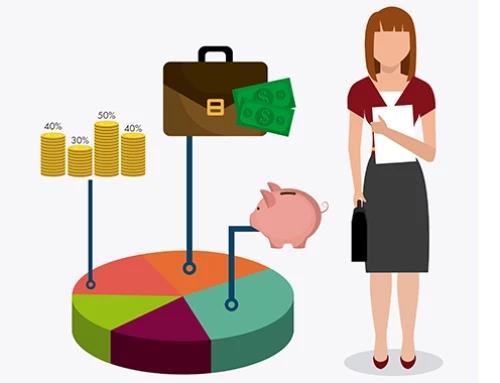Contents
Your Guide to Pre-Seed Funding for Startups
Pre-seed funding is the first phase of investment in a startup. It typically comes from angels and individuals who have not previously invested in startups, but it can also come from venture capital firms. The pre-seed stage of funding allows you to build your product or service and understand market demand before moving into the later stages of venture capital fundraising (Series A). In this article, we’ll cover what pre-seed funding is and how it works. We’ll also discuss some key points for getting started with pre-seed funding, including sources for pre-seed capital and tips for structuring your deal with investors.
Pre-Seed: The First Form of Funding for Your Startup
Pre-seed funding is the first round of funding raised by a startup. It’s usually between $100k and $500k, and it’s much smaller than seed funding, which begins at around $1 million.
Pre-seed funding is generally provided by angels or other private investors (as opposed to venture capitalists). Angel investors typically invest in startups with less traction or product development than venture capital firms would prefer to see before providing their own money; however, angel investors often have more experience investing in startups than VCs do, so they’re sometimes better positioned to spot promising businesses early on.
Sources of Pre-Seed Capital
Pre-seed funding can come from a variety of sources, including:
- Angel investors — are individuals who invest in early-stage companies for the sake of profit and potentially a return on their investment. They are typically interested in the industry you’re entering and are often tech or business savvy.
- Family and friends — these are people that you know personally who have the means to invest in your company but aren’t likely to get involved beyond an advisory role. If you bring them into your business plan as investors, ensure they understand what they’re getting into by sharing their financial information with you (and vice versa).
- Crowdfunding platforms—you can raise money through crowdfunding sites like Kickstarter or Indiegogo by offering incentives to those who donate money to help launch your product or service (e.g., T-shirts), which makes this option ideal if there’s something tangible that can prove its value when it’s produced. However, keep in mind that these platforms often require campaign deadlines before providing any funds — that means taking the time to prepare promotional materials, including videos, demonstrating how your product works.
- Venture capital—this is money provided by a firm or individual, typically with a proven track record in investing, who invests your company’s funds in exchange for equity. This option works best if there are already investors looking to invest that amount of money into your company. Business incubators—these organizations provide resources such as office space and access to mentors but also usually require you to give up some portion of equity or revenue from the business. Government grants—there are many government grant options available
- SBA loans—these are low-interest loans for startups designed to help them get off the ground and succeed in their first years. Microloans can range from a few hundred dollars up to $50,000 depending on your needs. If you qualify for this loan type, it’s vital that you only borrow what you need because interest rates tend to be higher than traditional bank loans. Also, keep in mind that these funds will likely have restrictions on how they can be used.
- Microloans—these loans are usually for amounts up to $35,000, which makes them a great option if you need some extra cash but don’t want to take on debt. These funds can be used for just about anything, including materials and supplies or marketing costs.
- Government grants—these are available at both the federal and state level, making them an excellent option for startups. Some of the best government grants include the SBIR (small business innovation research) program, which provides funding for scientific research and development projects by small businesses that qualify under certain criteria.
- Business incubators—these organizations help startups grow by providing them with office space, equipment, and other resources. They are a great way to get off the ground without having to pay for everything yourself.
Allocating Pre Seed Funding
Pre-seed funding is a great way to get your startup off the ground, but it’s not easy to find. One of the best ways to find pre-seed funding is through angel investors.
Angel investors are individuals who invest in startups with the hope of seeing them grow into successful businesses and make money for themselves along the way. They are typically interested in a particular field and will only invest if they believe their expertise can make a difference. Because of this, angel investors are often more willing than venture capitalists (VCs) to support companies that aren’t quite ready for full-scale investment—or even for seed financing at all!
If you want your business to succeed and grow, it’s important that you take advantage of every opportunity available; this includes meeting with angel investors when possible. If you’re interested in getting started raising funds from angels, here’s what you need to know:
If you don’t have the time or resources to make a pitch deck for angel investors, you can always put together one of these ten slides instead. The purpose of a pitch deck is to convince potential investors that your company is worth investing in, so it needs to be as simple as possible and include only the most critical information. You should also make sure you’re clear about what your product does–don’t leave them guessing!
Establishing credibility is critical for any investor. Make sure your deck shows them how much you know about the market, how well you’ve researched the competition, and how confident you are that your product can succeed.
Working with Angels: Structuring Your Deal
On the other hand, if you’re seeking to raise a large amount of money (more than $1 million), it’s probably not worth giving up more than 10% of your company at this stage. If you’re running a consumer-oriented business with high growth potential, 20% is an amount that makes sense for angels to invest in you.
If you’re looking for institutional investors who can bring significant value to the table beyond just their capital, then 30% might be an option. But be prepared for them to put conditions on their investment, including board seats and veto rights over major decisions (like hiring).
The third factor to consider is how much control you’re willing to give up. It’s often the case that the more money you raise, the more control you’ll have to give up in order to get it. If you’ve raised less than $1 million, your investors will probably be passive, and they won’t want a seat on your board of directors.
If you’re raising between $1 million and $5 million, you’ll need to give up some control in order to get the funds you need. You might have a board seat, or your investors might be able to veto certain decisions that they disagree with. If you’re raising more than $5 million, then it’s likely that your angel investors will want a board seat or rights of veto as well.
Avoiding Bad Terms in Your Deal
In addition to the terms of your deal, there are also some less obvious legal issues you should look out for before signing on the dotted line. Although these may not be as important as other terms in a given deal, they can still significantly impact how much control you retain over your company and its products.
For example, if someone is going to own any portion of your company (as with an investor), it’s essential that they don’t get any extraordinary power over that portion without your consent—this includes veto rights over major decisions like selling shares or changing the management team. Likewise, even though patents aren’t exactly typical for early-stage startups, be sure that anything related to intellectual property rights doesn’t give away part of your product or idea without asking first!
Meet the VC Team and Advisory Board Prior to Signing the Deal Sheets
Although there is no such thing as a pre-seed funding deal without a term sheet – it’s one of the most important documents in your relationship with your investors, so you should read it carefully and understand everything before signing. You’ll want to make sure that everything in the term sheet aligns with what you discussed and agreed upon during meetings with members of the VC team.
So what should you do if something doesn’t match up? The answer is simple: ask questions! If any points are unclear or confusing, don’t be afraid to bring them up at this point instead of waiting until later on down the road when things may become more adversarial (and riskier).
You should also try to get a good sense of the VC team as well as their investment strategy before signing any documents. This will help ensure that you’re aligned with both their goals and expectations for your company in order to make sure there are no surprises later on down the road. The last thing any entrepreneur wants is an investor who doesn’t share their vision or values.
Valuation is Only Part of the Story
The valuation of a startup is only one part of the story. In fact, it’s often not even the most important part. The most important part is the value of your company and how much money you can make with it.
The most common mistake I see startups make when talking about seed funding is that they focus on valuation rather than building a business and showing that they have an idea worth investing in. And that’s because many don’t realize there are other ways to raise money besides venture capital or angel investors – or they get caught up in thinking all seed funding will be at high valuations (which isn’t always true).
When it comes to raising funds for your business, there are two paths: equity financing and debt financing. The first option is the most common and involves selling shares of your company to investors who then become shareholders. The second type is when you borrow money from an investor or lender (usually a bank) and pay them back with interest.
Get pre-seed funding from a credible source
The key here is to get pre-seed funding from a credible source and be focused on building a product that can solve real problems.
Pre-seed funding is not a guarantee of success, but it’s probably one of the best ways for startups to get started with building their products. In fact, many successful startups have received pre-seed funding before going on to raise larger rounds later on.
If you’re looking for pre-seed funding, you should think about who might be willing to invest in your company. Here are some possible sources:
*Friends and family. *Angel investors. *Venture capital funds.
Pre-seed funding is not a substitute for a good product, but it can help you get started and build momentum. When you’re ready to raise money, make sure that you have a solid plan and are focused on solving real problems.
Pre-seed funding is the act of obtaining funds for a startup before it’s ready to raise money from investors. It’s typically done by angel investors or family members, and it allows startups to get going without having to worry about securing funding from traditional sources. The key here is to get pre-seed funding from a credible source and be focused on building a product that can solve real problems. Pre-seed funding is not a guarantee of success, but it’s probably one of the best
Pre-Stage Funding vs Seed-Stage Funding for Startups
Seed funding is a type of initial capital that startups get to help them launch and get their first customers. Pre-seed funding, on the other hand, refers to money given by investors before the seed round is even closed. This allows entrepreneurs to plan ahead and have some extra cash in their pocket when they finally close it out. Although these two terms are often used interchangeably, they are actually quite different from each other if you look closely enough. Seed funding is a type of financing that can be used to start your business and get it ready for the next phase. It typically comes in the form of grants or loans from investors, but you can also find other ways to raise this money, like crowdfunding platforms.
Pre-seed funding is a stage between seed funding and Series A, which is when startups raise money from angel investors or venture capitalists (VCs). The difference between pre-seed funding and seed funding is simple: Seed funds are funds given by VCs or angels after an idea has been tested out through market research and validation techniques like customer interviews. Pre-seed funds are raised when the entrepreneur has had an initial idea and wants to get their product into development before approaching investors later down the line.
What is Seed Funding?
Seed funding is the first stage of venture capital funding. It is usually the first round of funding a startup receives, and it is used for product development and hiring. Seed funding can be in the form of equity or convertible debt, which means that if you sell your company to another company, you have to give them back their investment plus interest.
Pre-seed funding is very similar to seed funding but comes even before an idea has been formed or a prototype has been created. Basically, it’s a grant that helps fund research and development so that entrepreneurs can do all their thinking before they start fundraising and making any decisions about how they want to structure their business’ finances or equity structure (what percentage each person gets).
Types of Seed Funding
The first type of seed funding is venture capital, in which investors provide money to a startup in exchange for equity. In today’s market, that typically means 5 to 15 percent of the business. Average investments range from $500,000 to several million dollars per deal. Venture capitalists (VCs) are looking for an idea with high growth potential and proven management teams that can execute that idea.
VCs like startups that have already demonstrated traction by earning revenue or attracting users (or both). If your startup isn’t generating any sales at all yet, it’s unlikely VCs will be interested in taking part in your company’s growth at this stage—unless they believe there’s some technological breakthrough behind what you’re doing that makes it worth their while to invest early on.
Common Mistakes People Make When Seeking Seed Funding
The common mistakes people make when seeking seed funding include:
- Not having a clear vision for your business. If you’re not sure what you want to do with your business, it’s unlikely that anyone else will be able to figure it out either. Even if you have some ideas about what direction you’d like your company to go in, it’s best to wait until after the initial stages of building up and running the startup before investing in any kind of marketing campaign or advertising strategy that might impact how customers perceive the brand. This is one area where there’s no room for trial and error—you need to have everything figured out before moving forward with anything else in order for this stage of growth to be successful.
- Not having a clear idea of how you will use the money or where it will come from later on down the road when other options become available (such as venture capital). Pre-seed funds are meant primarily as development capital; they won’t help much at all once actual users start coming onboard because then there’ll be plenty more money available elsewhere (I’m talking millions here!).
- Having no plan at all regarding how much money should be spent each month during development phases versus production phases versus marketing/advertising phases …
What is Pre-Seed Funding?
Pre-seed funding is a type of seed funding. It comes before the main stage of funding, and it usually covers tasks like product development and market research.
While in the pre-seed stage, you’re working on your product, getting it ready for release and building an audience through online marketing efforts. As you’re preparing for launch, you can also work on things like customer acquisition strategies or hiring talent to help build out your team.
The cost for this type of financing varies depending on what stage your business is in—if it’s just starting up or if you have a successful product already launched and generating revenue but are looking for additional capital to grow even faster.
If you’re going after pre-seed capital as part of an equity investment round (meaning there’ll be investors involved), keep in mind that most funds will require some sort of return on their investment within five years from when they made their initial investment—so make sure any plan includes milestones or goals that will get them there!
Pre-seed funding is a great way for startup companies to get started. It offers entrepreneurs the opportunity to gauge their ideas and see if they are worth pursuing further. Pre-seed funding can also help entrepreneurs get their company off the ground in terms of infrastructure, hiring employees, or even just paying bills while they work on their product or service.
How to Manage Your Pre-Seed Funding Opportunities Like a Pro
Remember that getting funded is one part of the process, but there’s no substitute for hard work and persistence. If you want to learn more about raising money from angels or VCs, check out our other articles on fundraising. No matter if your startup is more suited to pre-seed funding or seed-stage investment, remember that without using the right tools like a CRM for VC with tools like deal flow tracker and funding opportunity manager, you’re likely to lose more funds than you would otherwise. RunSensible is a feature-rich CRM and startup management tool with all the right tracking and organizing tools to help you boost your chances of success.
Disclaimer: The content provided on this blog is for informational purposes only and does not constitute legal, financial, or professional advice.






